by Samantha Kennedy | Oct 26, 2017
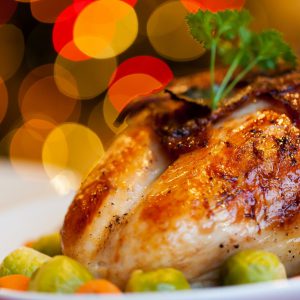
Photo credit:
www.Pexels.com (Creative Commons License)
According to the National Turkey Federation, 88% of American families eat turkey on Thanksgiving. That’s over 46 million turkeys! Served as the main dish, it is complemented by a variety of sweet and savory side dishes, many of which are family traditions made from recipes passed down through the generations.
Why do we eat turkey on Thanksgiving, anyway? Well, it’s kind of a funny story. While historians generally agree that turkey wasn’t eaten at the First Thanksgiving in Plymouth in 1621, it was well-documented that settlers often hunted wild turkeys as a source of protein, and subsequent celebrations often included turkey. After President Lincoln declared Thanksgiving a national holiday in 1863, turkey became a staple on many Thanksgiving tables.
When choosing a turkey, there are a few decisions to make. How many people will be eating? Will it be roasted, smoked, or deep-fried? Is frozen or fresh preferred?
When it comes to the proper size, a pound per person is a great rule of thumb. This includes the total weight of the bird, not just the meat. Also, the ratio of white meat to dark meat is about 7:3 (70% white meat, 30% dark), so if there are a lot of dark meat lovers around the table, additional thighs and drumsticks may need to be purchased.
Roasting is the most common way to cook a turkey. This method involves placing the turkey in a large roasting pan and cooking it in the oven slowly over several hours. The turkey is usually placed breast-side up in the pan and basted periodically to prevent drying. The lid or foil is also removed the last 30 to 45 minutes of roasting time to brown the skin and give the turkey that gorgeous presentation.
Vegetables such as potatoes, carrots, or Brussels sprouts may be added to the roasting pan to cook concurrently. For best results, roast the turkey at 325˚F for 15 minutes per pound. For example, a 15 pound turkey would take 3 hours and 45 minutes.
Smoked turkeys are usually fully cooked (read the label to be sure) and just need to be reheated. Keep in mind, smoking is done to impart flavor and does not increase the turkey’s shelf life. Follow the instructions on the package to properly reheat the turkey.
Deep-fried turkeys are submerged in very hot oil and cook more quickly than roasted turkeys. Turkeys can be deep fried in a very large stockpot or in a designated turkey fryer. Only use enough oil to cover the turkey. Too much oil can cause a fire or overflow when the turkey is added to the cooker.
To determine the amount of oil, place the turkey in the cooker and add enough water to cover the bird. Then remove the bird. The water line will indicate the level of oil needed to adequately fry the turkey. For best results, let the turkey warm to room temperature before frying, and fry the turkey for 3 minutes per pound plus 5 minutes per bird.
Remember, the size of the cooker will dictate the size of the turkey. The turkey should fit easily without being forced. Wedging a turkey into a cooker that is too small could cause uneven cooking, or worse, a fire.
As for frozen versus fresh, there is no difference in flavor. However, frozen turkeys can be purchased months in advance and kept frozen until needed. Fresh turkeys should be purchased no more than two days in advance for maximum safety and freshness.
The safest way to thaw a frozen turkey is in the refrigerator. This will take pre-planning. The general rule of thumb is 24 hours of refrigerator thawing per 5 pounds. For example, a 15 pound turkey should take 3 full days (72 hours) to thaw completely.
However the turkey is cooked this year, have a Happy Thanksgiving!
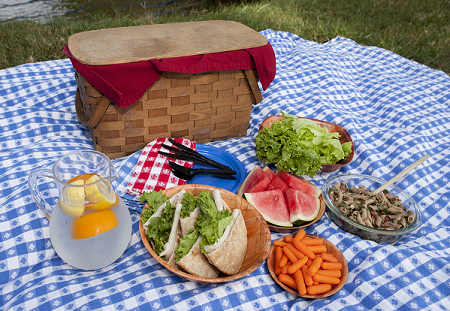
by Samantha Kennedy | Jun 27, 2017
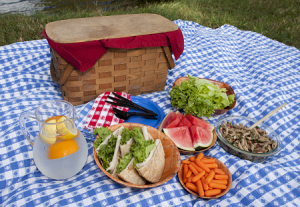 There are few things more iconic during summer than a picnic. There’s just something fresh and fun about sharing a meal in the park or at the beach with family and friends. But just because you’re enjoying the warm, gentle breeze doesn’t mean you should throw caution to the wind. By following a few simple food safety tips, you can ensure that your perfectly planned picnic doesn’t make you sick.
There are few things more iconic during summer than a picnic. There’s just something fresh and fun about sharing a meal in the park or at the beach with family and friends. But just because you’re enjoying the warm, gentle breeze doesn’t mean you should throw caution to the wind. By following a few simple food safety tips, you can ensure that your perfectly planned picnic doesn’t make you sick.
Planning it out. Not all foods are picnic-appropriate. Anything that requires a lot of perishable ingredients and/or a lot of preparation should be avoided. Stick with foods that require little or no cooking and that contain just a few ingredients. Foods such as fruits and vegetables (especially whole ones), hard cheeses, peanut butter and jelly, cereal, bread, and crackers are ideal picnic items. Anything made with commercially processed custard or mayonnaise will stay safe as long as they are kept cold.
Packing it up. Use a cooler, if possible, and store cold foods together so they can help each other stay colder longer. Use ice or frozen gel packs to help keep foods cold. Pack foods directly from the refrigerator into the cooler; don’t leave them sitting out before packing. Store ready-to-eat foods separately from raw meats. If packing up hot foods, be sure to keep them in a thermos or other insulated dish. DO NOT store them in the same container as the cold foods. Paper towels, disposable utensils, and a food thermometer are ideal picnic accessories. Remember, keep cold foods below 41 degrees F and hot foods above 135 degrees F. Do your best to keep the cooler away from direct sunlight by storing it in the shade and be sure to replenish the ice and/or frozen gel packs when they melt. Consider packing drinks in a separate cooler, as they are consumed more frequently; this will reduce the exposure of food items to warm air until you’re ready to eat.
Preparing the feast. All food items should be kept at the proper temperature at all times. When cooking raw meats, use separate plates for the raw and cooked products and clean and sanitize utensils between uses. Cook meat to the proper recommended internal temperature to ensure doneness and safety. Click here for a list of recommended internal cooking temperatures.
Presenting the bounty. Discard any perishable foods that have been left out for longer than two hours. In really hot weather (generally above 90 degrees F), foods should not be left out longer than one hour. Keep food protected in storage containers such as coolers and lidded dishes to minimize contamination from flies and other pests. Serve small portions of food at a time and keep the rest in the cooler.
Picnics are an important part of summer and with just a little bit of planning and a few useful tips and tools, they can be safe and delicious for everyone!
Source: Beaugh, Kristina. “Checklist for the Perfect Summer Picnic,” Foodsafety.gov blog, June 16, 2015. URL: https://www.foodsafety.gov/blog/2015/06/picnic.html.
by Dorothy C. Lee | Jun 11, 2017
June is National Dairy Month. National Dairy month was first celebrated in 1937 to encourage Americans to drink more milk.
Milk and dairy products comprise a diverse group of foods from fluid milks, fermented milk products, and over 500 cheeses.
Generations of American children have grown up hearing the same parental advice, “Drink your milk…..milk builds strong bones and teeth.”
Milk has long been associated with good health, making it one of the heathiest beverages consumed in the United States. Current Dietary Guidelines recommend daily consumption of dairy for greatest impact. The body requires essential nutrients to maintain optimal health. Milk and dairy products are rich in many of these nutrients. Milk and dairy products contain calcium, vitamins A, D, B12, and high quality protein. The body absorbs calcium with the aid of vitamin D, both of which are found in fluid dairy products. Milk, whole, low fat, and skim, are homogenized and vitamin D fortified.
The amount of consumption from the dairy food group depends on age. Generally one cup of milk, yogurt, or one and a half ounces of cheese is considered a serving from the dairy group.
The cost of milk and dairy products varies. Careful selection can result in substantial savings. Milk generally is less expensive as a source of calcium than other dairy products.
Effective shopping skills depend on understanding and using information on the label including nutrition facts, product date, contents and ingredient statements. Usually larger containers, such as half gallon to a gallon cost less than single quarts. Compare the cost of the number of servings.
Milk and dairy products are highly perishable, so careful handling and storage to prevent spoilage, preserve flavor and retain nutritional uniformity is needed.
Florida regulations call for uniform standards for dating milk and requires all dairy processors to label milk and dairy product containers with the last date the product can be offered for sale. The date on the container does not mean that the milk will be spoiled on that date; it indicates that the milk should not be sold beyond that date. This is to insure a reasonable shelf life in your refrigerator after it is purchased. The quality and flavor are still dependent upon careful handling and storage. Remember, milk and dairy products are highly perishable and should be kept cold.
In recent years many kinds of alterative milk products have appeared in the market place. In choosing a dairy milk or dairy alternative you should be aware of the different alternative milk products available and what makes them different. With so many kinds of milk and milk alternatives on the market, reading the labels on containers to recognize differences in the contents is well worth while. Here is information on some of the more popular forms of milk alternatives now available and an explanation of some special terms you may find on labels and facts that may help in buying.
-
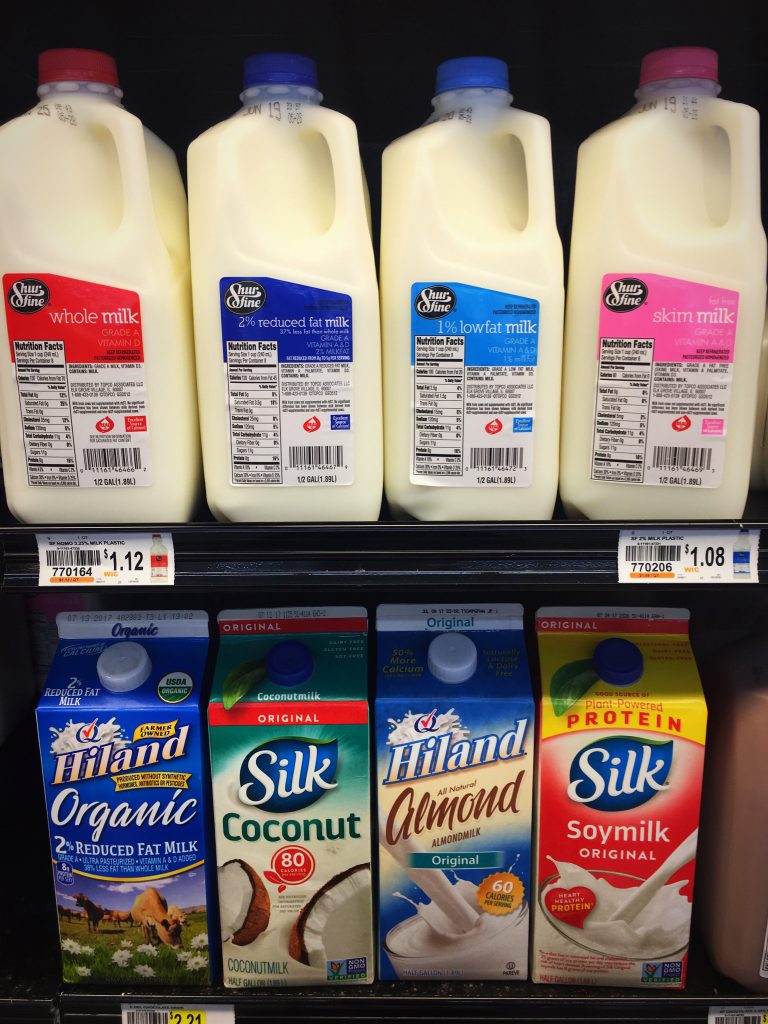
Variety of milks Picture by Wendy Meredith
Almond
- Low-fat
- 40 calories
- 1 gram protein
- Low in protein or calcium content. Nutty flavor.
- Coconut
- 420 calories per cup
- 3 grams protein
- 45 grams fat
- High in fat content.
- Hemp
- Made from hemp seeds
- Contains 10 essential amino acids
- 80-140 calories per cup
- 3 grams protein
- Grassy flavor. Tends to separate when added to hot beverages.
- Rice
- 130 calories per cup
- 1 gram protein
- 2 grams fat
- Low in fat and protein content. Higher in carbohydrates.
- Soy
- 110 -130 calories per cup
- 7-11 grams protein
- 4 grams fat
- Higher in protein content. Thick texture often taste.
There are many ways to add milk into meals. Many people find milk refreshing and never tire of drinking it plain. However, cooked foods and other prepared foods offer many additional ways to add more milk into daily food, always with much added nutritive value and often extra dividends in flavor. Use milk instead of water when preparing cooking cereal, or add milk when preparing soups, mashed potatoes, custards sauces and other cooked foods. Beverages made with milk or milk products fit into meals and snacks and add extra nutritive values to daily fluid intake.
June is National Dairy Month, but milk is needed for good health every day of the year.
References;
https://www.ams.usda.gov/about-ams/programs-offices/dairy-program
https://www.choosemyplate.gov/
https://health.gov/DietaryGuidelines/
For further information, contact:
Dorothy C. Lee, C.F.C.S.
UF/IFAS Extension Escambia County
3740 Stefani Road
Cantonment, FL 32533-7792
(850) 475-5230
by sbouie | Aug 28, 2016
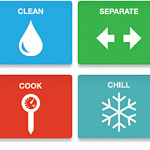 September is National Food Safety Month. However, food safety should be practiced every day of the year and for every meal and/or snack. We live in a busy society. We are always in a rush to do and to go to whatever we have planned.
September is National Food Safety Month. However, food safety should be practiced every day of the year and for every meal and/or snack. We live in a busy society. We are always in a rush to do and to go to whatever we have planned.
When it comes to our food, we need to make the time to observe steps to food safety. Food safety will decrease the opportunity for food borne illness. The steps are as follows:
- Clean – everything that touches the food. This includes hands, utensils, surfaces, and foods – fruits, vegetables, but not meats or eggs. Wash hands in hot water and soap for at least 20 seconds. Bacteria can get on cutting boards and utensils. Rinse fresh fruits and vegetables under running tap water, including those with skins and rinds that are not eaten. Rub firm-skin fruits and vegetables under running tap water or scrub with a clean vegetable brush while rinsing with running tap water.
- Separate – surfaces used for raw meats and eggs from other foods or surfaces when shopping, storing, preparing, and cooking. This will prevent cross-contamination.
- Cook – food at the correct temperature by using a food thermometer (see the chart below). The danger temperature zone is 400 to 1400 Fahrenheit. This is when bacteria rapidly grows.
- Chill – Refrigerate perishable foods within two hours. Never thaw or marinate foods on the kitchen counter.
After you remove meat from a grill, oven, or other heat source, allow it to rest for the specified amount of time. During the rest time, its temperature remains constant or continues to rise, which destroys harmful germs.
| Category |
Food |
Temperature (°F) |
Rest Time |
| Ground Meat & Meat Mixtures |
Beef, Pork, Veal, Lamb |
160 |
None |
| Turkey, Chicken |
165 |
None |
| Fresh Beef, Veal, Lamb |
Steaks, roasts, chops |
145 |
3 minutes |
| Poultry |
Chicken & Turkey, whole |
165 |
None |
| Poultry breasts, roasts |
165 |
None |
| Poultry thighs, legs, wings |
165 |
None |
| Duck & Goose |
165 |
None |
| Stuffing (cooked alone or in bird) |
165 |
None |
| Pork and Ham |
Fresh pork |
145 |
3 minutes |
| Fresh ham (raw) |
145 |
3 minutes |
| Precooked ham (to reheat) |
140 |
None |
| Eggs & Egg Dishes |
Eggs |
Cook until yolk and white are firm |
None |
| Egg dishes |
160 |
None |
| Leftovers & Casseroles |
Leftovers |
165 |
None |
| Casseroles |
165 |
None |
| Seafood |
Fin Fish |
145 or cook until flesh is opaque and separates easily with a fork. |
None |
| Shrimp, lobster, and crabs |
Cook until flesh is pearly and opaque. |
None |
| Clams, oysters, and mussels |
Cook until shells open during cooking. |
None |
| Scallops |
Cook until flesh is milky white or opaque and firm. |
None |
Food is for the nourishment of our body, not to make us sick. Take the time to clean, separate, cook, and chill foods to avoid food borne illness. For more detailed information and videos, visit www.foodsafety.gov and www.fightbac.org.
Sources: www.foodsafety.gov; www.fightbac.org
by Dorothy C. Lee | Aug 28, 2016

Does lettuce turn brown and slimy in your refrigerator? Is that two-year-old frozen turkey still safe to eat? Should you dispose of that slightly moldy cheese? “When in doubt throw it out” is definitely a safe practice to follow. However, throwing food out is like throwing money away. A few simple guidelines for food storage can save dollars and time spent on shopping.
Dairy Do’s and Don’ts
- Buy milk in cardboard cartons or non-translucent containers. Translucent containers allow light to seep in, which can cause the milk to spoil. Store milk in a refrigerator that is set at 40° or lower. Don’t store milk in the door of the refrigerator. Items stored in the door of the refrigerator are more susceptible to warm air that enters the refrigerator each time the door is opened.
- Discard unused milk after the container has been opened for a week. Milk may be frozen for up to three weeks.
- Ice cream has a shelf life of two to four months as long as it is stored in a freezer that is set at zero degrees Fahrenheit.
- Yogurt should be used within seven to ten days of purchase.
- Butter may be refrigerated, tightly wrapped, for up to one month and be frozen for six months.
- Hard cheeses will keep for three or four weeks, tightly wrapped, in the refrigerator once they have been opened. Processed cheese spreads will keep for three to four weeks after opening.
- Purchase eggs before the sell by date. Store eggs in their original packaging on the middle or lower shelf of the refrigerator. Refrigerated uncooked eggs will keep for three to four weeks from the time they are purchased. Hard boiled eggs in the shell will keep for one week. Don’t freeze hard cooked whole eggs or egg whites. They will be tough and watery when defrosted. Raw egg whites can be frozen in ice cube trays.
Meat and Poultry
- Store meat and poultry in a refrigerator set at 35° to 40° Fahrenheit.
- Put packages of raw meat, poultry, or fish on a plate before refrigerating so their juices won’t drip on other foods. Raw juices often contain bacteria.
- Follow the “use by”, “keep refrigerated”, and “safe handling” information on the packaged meat label.
- Meat should be cooked or frozen within a few days of purchase.
- Use chicken by the sell-by date unless you plan on freezing it.
- Chicken and turkey may be frozen for nine months to a year.
- Cooked chicken or turkey should be eaten or frozen within three to four days of preparation.
Fruits and Vegetables
- Use refrigerated fruits and vegetables within a few days of purchase. Wash vegetables and fruits thoroughly right before eating or preparing.
- Fruits and vegetables stored at room temperature should be stored in perforated bags away from direct sunlight.
Canned Food Items
- Don’t purchase cans that are dented, bulging, or rusted.
- Store canned goods in a cool dry place.
- Rotate canned food items on a timely manner to establish a well-stocked pantry.
- Shelf life is determined by the acid content of the canned food.
To assure safe food storage, USDA recommends an appliance thermometer be installed in all refrigerators and freezer sections. Appliance thermometers are available at local supermarkets or discount stores. The refrigerator section should be set at 40°F and freezer section at 0°F.
Safe food storage is top priority to prevent foodborne illness. So remember, “Store It Right!”
For further information, contact:
Dorothy C. Lee, CFCS
UF/IFAS Extension Escambia County
3740 Stefani Road
Cantonment, FL 32533-7792
(850) 475-5230
dclee@ufl.edu
Reference: www.USDA.gov
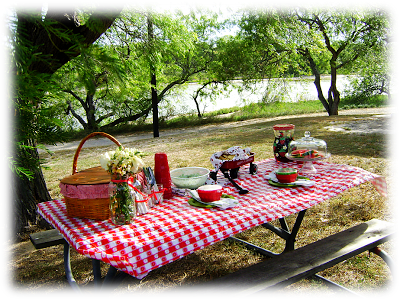
by sbouie | Jul 17, 2016
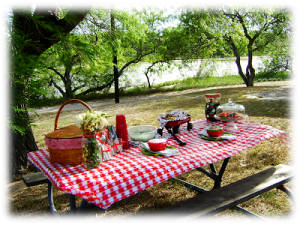 Picnics are a great opportunity for families to enjoy the great outdoors. It provides time to experience special bonding while enjoying the fresh air and delicious food. However, we should always be cautious of food borne illness.
Picnics are a great opportunity for families to enjoy the great outdoors. It provides time to experience special bonding while enjoying the fresh air and delicious food. However, we should always be cautious of food borne illness.
Let’s keep food and your family safe from the start! Whether the foods are from home, a store, or restaurant, follow the simple rules of keeping hot foods hot and cold foods cold. Remember that bacteria can grow fast at temperatures between 40°F and 140°F – the Danger Zone. Eat and promptly chill leftovers within two hours, and if the outside air temperature is above 90°F, do so within one hour.
If you plan to cook on site, make sure raw meats are packed well and are separated from ready-to-eat foods to prevent any cross-contamination. All perishable foods must be kept cold (40°F or below) in insulated boxes with enough ice, frozen gel packs, or other cold source, such as a container of frozen water. If possible, bring an appliance thermometer along to monitor the box temperature. When you grill the meat, make sure it is cooked to the right temperature. Also, bring enough potable water if none will be available at the site, and pack clean, wet, disposable cloths or moist towelettes and paper towels for cleaning hands and surfaces. Keep your tailgate party fun and bacteria-free for your family’s well-being!
Besides the food, plan your time. Plan some fun outdoor games that the entire family will enjoy. You may even plan a nature walk, name the cloud’s shape, or be creative and create your own activity. Whatever you plan, always involve the entire family. Every family member should be included.
This is the best time to say “no electronic devices.” This is time for the family to have face time without interruptions – time to talk to each other and grow closer. Picnic time translates “it’s family time” – eating outside in the fresh air and enjoying your family.
Reference: Food Safety and Tailgating, Amy Simonne. EDIS Publication #FAR8712








